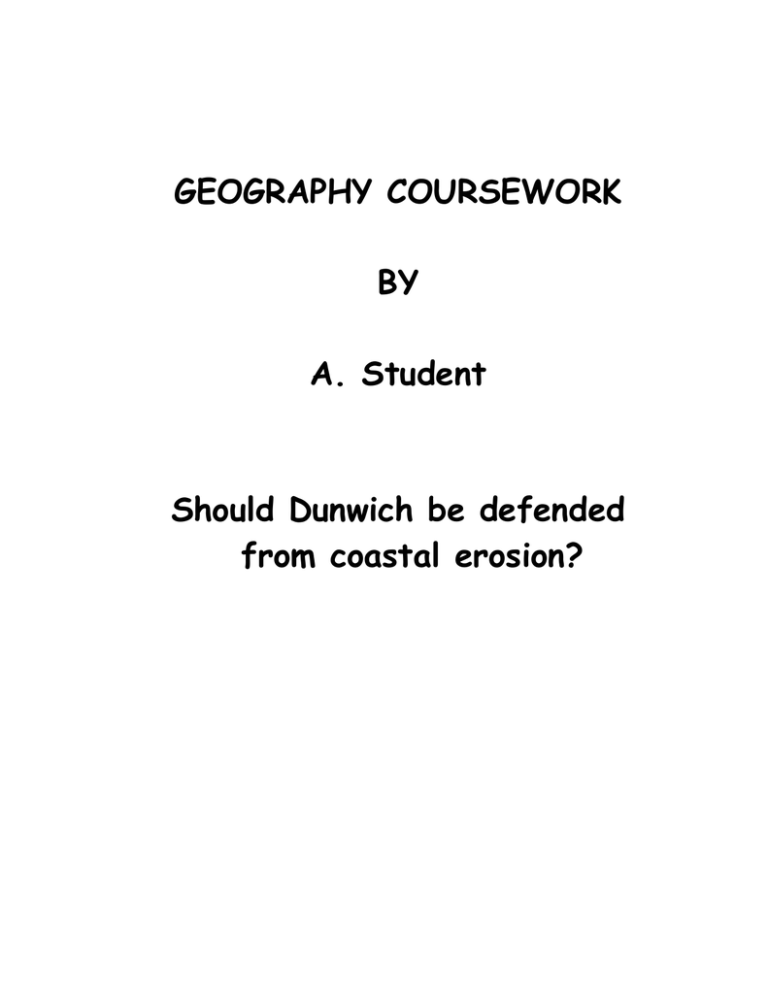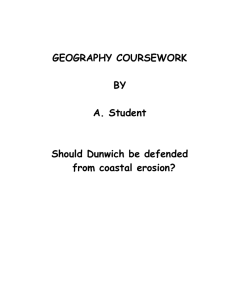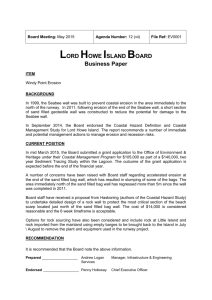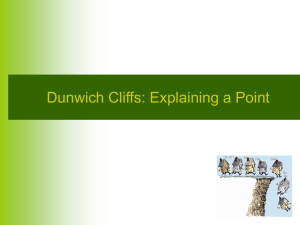Example Geography Coursework (DOC, 98 KB)
advertisement

GEOGRAPHY COURSEWORK BY A. Student Should Dunwich be defended from coastal erosion? Introduction Aims of the project The purpose of this coursework is to collect enough information so we can answer the question “Should Dunwich be defended from coastal erosion?” We will also be able to learn about coastal erosion and other coastal processes. About Dunwich Dunwich is a small village on the east coast of Suffolk. It has a beach and attracts tourists in the summer. It is a quiet, rural area with Southwold to the north and Sizewell power station to the south. It is a sparsely populated area. Issues and values If Dunwich was defended from coastal erosion it would affect other places in the surrounding area along the same part of the coast and we need to decide if it is worthwhile. We need to decide which measures would be cost-effective and if any propose coastal defences would be harmful to the environment. But whatever the answer there will be some people against the idea and some for it. I will need to develop my own opinions and values. 2 Key questions Where is Dunwich? It is a small town in the Suffolk Coastal district of the county of Suffolk, England, on the North Sea coast. The first development on the site was probably a Romano-British community, and in Anglo-Saxon days it became the most important commercial centre in East Anglia. Early in the 7th century, when Sigebert became king of East Anglia, Dunwich was chosen as his capital, and a bishopric was founded before 650. The community received a charter from King John (reigned 1199-1216). Dunwich became a wealthy port, but severe coastal erosion caused its decline. In 1347 more than 400 houses were washed away in a storm, and similar disasters occurred in 1570. Until 1832, Dunwich returned two members to Parliament in spite of its small population. The corporation was abolished in 1886. Pop. (1981) 129. How has Dunwich been affected by erosion over the years? Over the past 400 years approximately one metre of land per year on average has been eroded What coastal processes operate and what coastal features are there at Dunwich? This is covered in the next chapter where a beach profile and a cliff profile are discussed What coastal defences are there? In the 15th Century, the inhabitants of the village devised a way of defending the coast. Each autumn they would tie up piles of wood and shingle and place them at the base of the cliffs. This was a very effective method of defence for over 200 years. There are not many coastal defences at Dunwich, just some sand dunes and clay banks. These are not very good defences as the sand dunes are worn away by people walking on them and the only thing holding them together is Marram grass. What options exist for defence against coastal erosion? The following options exist: Rock revetment – approximate cost $4500 per metre of coast, but variable. Offshore rock barrier (breakwater) – approximate cost £6500 per metre. Wave return wall – cost £6000 per metre of coast. Groynes – Approximate cost: £5000 per groyne 3 Data Collection History of erosion In the 5th Century Dunwich was a port on the bay shoreline, approximately 2 KM from the open sea. From 1587 – 1702 107m of land was removed. Between 1702 and 1754 a further 160m was eroded and up to 1973 121m were removed. In 386 years, 388m of coastline have been lost (approximately 1m per year), although this has not been true in all areas. Most rapid erosion rates over 5 years are: South of Millgate Street South of Greyfriars All Saints graveyard 4 feet 14.5 feet 11.5 feet 4 Beach Profile 3.5 3 Weight (m) 2.5 2 1.5 1 0.5 0 1-2 2-3 3-4 4-5 Pole number 5 5-6 6-7 Cliff Profile This shows the cliff profile that I did on the visit to Dunwich, so that we could see what the land is made of and whether it is prone to erosion. Brown soil 15cm Orange/grey soil 15cm Light grey soil 30cm Humus – decomposed plant matter Sand & clay 1 – 1.5m Pebble – old river bed Orange sand with clay Dark orange/brown iron pan Small grain sand 6 Data Analysis Timeline In the 5th century Dunwich was inland, approx. 2KM from the sea 1587 107m of land removed 1702 160m eroded 1754 121m eroded 1973 7 Graph to show pebble size Pebble size 60 50 Pebble size (mm) 40 30 20 10 0 1-2 2-3 3-4 4-5 Pole Number 8 5-6 6-7 Graph to show beach profile 3.5 3 Weight (m) 2.5 2 1.5 1 0.5 0 1-2 2-3 3-4 4-5 Pole number 9 5-6 6-7 Cliff composition Brown soil Orange/grey soil Light grey soil 15cm 15cm 30cm Humus – decomposed plant matter Sand & clay 1 – 1.5m Pebble – old river bed Orange sand with clay 15cm Iron pan Small grain sand To bottom of cliff 10 Field sketch pylons Inlet and outlet pipes Sizewell A & B Marram grass sea Clay barrier Sand dunes Beach lagoons forest marshland 11 Coastal defences Rock revetment 5 to 10 tonnes hard rock armour Filter layer of smaller rock as a base for rock armour Offshore rock barrier About 200m offshore 12 Rock barrier to dissipate wave energy before waves reach the shore Conclusion What is the best decision for coastal management at Dunwich? After gathering all this information about Dunwich I have come to the conclusion that it is too late for Dunwich to be defended from coastal erosion. This is because there is nothing left to defend except the houses, so there is no point in spending money on defending Dunwich. If any money was to be spent then only soft defences should be used. Defending Dunwich from coastal erosion could also have serious repercussions along the coast and it should not be forgotten that the Sizewell A and B Power Station are a little way along the coast 13








